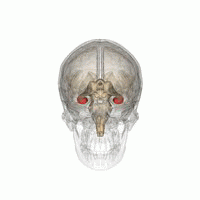
Photo from wikipedia
GABA is the chief inhibitory neurotransmitter in the adult brain. However, in the developing brain it acts as an excitatory transmitter causing depolarization. Thereby, activates calcium-dependent processes that are crucial… Click to show full abstract
GABA is the chief inhibitory neurotransmitter in the adult brain. However, in the developing brain it acts as an excitatory transmitter causing depolarization. Thereby, activates calcium-dependent processes that are crucial for brain development. Accordingly, GABA receptors have the great role in the brain development, especially in the area with persisting neurogenesis such as hippocampus. The present study investigated the development and lateralization of two important subunits of GABA receptors, GABAAα1 and GABAB1, in the developing rat hippocampus during the neurogenesis-active period, at the first two postnatal weeks. Real-time PCR, western blot and immunohistochemistry were used. We found that the mRNA and protein of these GABA receptor subunits have already been expressed at birth and significantly increased at postnatal day (P) 7, and also at P14. Also, regarding the optical densities of GABAAα1 and GABAB1 expressing hippocampal cells, we found a significant increase in the distribution pattern of these subunits in the all hippocampal subregions on day 14 after birth. The highest optical density of GABAAα1 was observed in the CA3, and GABAB1 in the CA2 at P14. Nevertheless, our results did not show asignificant laterality differences in the general expression of these subunits, and there were only differences in hippocampal subregions. Regarding the crucial role of GABA receptors in the hippocampus development; they probably have the same effects on development of the rat hippocampus on both sides.
Journal Title: International Journal of Developmental Neuroscience
Year Published: 2019
Link to full text (if available)
Share on Social Media: Sign Up to like & get
recommendations!